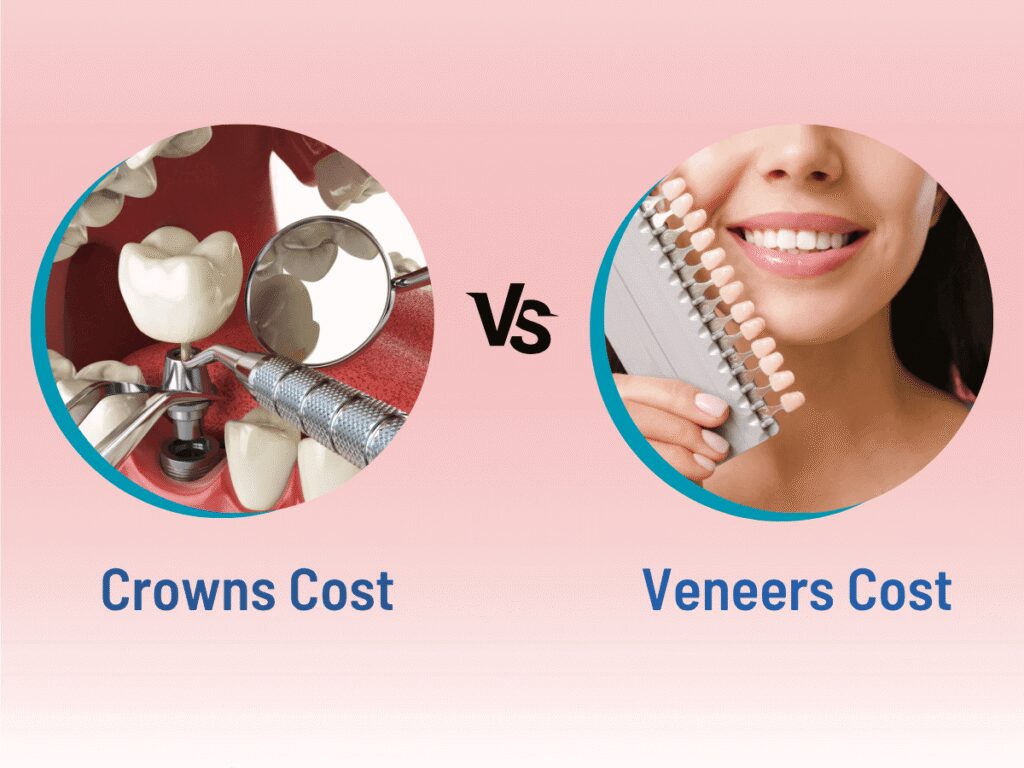When considering cosmetic dental treatments, two of the most popular options are dental crowns and veneers. While both can dramatically improve your smile’s appearance, they serve different purposes and come with significantly different price points. The crowns vs veneers cost comparison reveals substantial variations in pricing, insurance coverage, and long-term value. Understanding the cost differences, along with what influences pricing for each treatment, can help you make an informed decision about which option best fits your needs and budget.
When restoring damaged teeth or aiming to boost your smile’s appeal, being aware of the costs involved in each treatment helps you make smart choices for your oral health and wallet.

| Factor | Dental Crowns | Dental Veneers |
| Average Cost per Tooth | $800 – $3,000 | $500 – $2,500 |
| Porcelain Options | $1,000 – $3,000 | $900 – $2,500 |
| Composite Options | $300 – $1000 | $500 – $1,500 |
| Typical Treatment Duration | 2-3 weeks | 2-3 visits |
| Insurance Coverage | Often partially covered | Rarely covered |
| Lifespan | 10-30 years | 7-20 years |
What Are Dental Crowns?
Dental crowns are tooth-shaped caps that completely cover a damaged or weakened tooth, restoring its shape, size, strength, and appearance. These restorative devices provide complete protection for teeth that have suffered significant damage from decay, trauma, or extensive dental work.
Crowns serve both functional and aesthetic purposes, making them essential for preserving tooth structure while improving appearance. When a tooth is severely damaged or has undergone root canal treatment, a crown becomes the primary method of protection and restoration. The comprehensive coverage provided by crowns makes them ideal for teeth that need both structural support and cosmetic enhancement.
Key characteristics include:
- Complete tooth coverage from the gum line to the biting surface
- Restoration of full chewing function
- Protection against further damage or decay
- Available in multiple materials to match natural teeth
- Often medically necessary rather than purely cosmetic
What Are Dental Veneers?
Dental veneers are thin shells of porcelain or composite resin bonded to the front surface of teeth to improve their appearance. Unlike crowns, veneers only cover the visible front portion of teeth, making them primarily a cosmetic solution for aesthetic concerns.
The cosmetic nature of veneers means they’re designed to address surface-level imperfections rather than structural damage. This fundamental difference significantly impacts both pricing and insurance coverage when comparing the cost of crowns and veneers.
Types of veneers available:
- Porcelain veneers offer superior durability and stain resistance
- Composite veneers provide a more affordable immediate solution
- No-prep veneers requiring minimal tooth alteration
- Instant veneers for same-day smile improvements
Detailed Cost Breakdown for Crowns
The crowns vs veneers cost analysis reveals that crown pricing varies significantly based on material selection and treatment complexity. Understanding these cost factors helps patients budget appropriately for their dental investment.
Material choice represents the largest cost variable in crown treatment. Porcelain crowns, ranging from $1,000 to $3,000 per tooth, offer the best aesthetic results and durability but command premium pricing. Metal crowns, priced between $600 and $1,200, provide excellent strength but lack aesthetic appeal for visible teeth. Zirconia crowns, costing $1,000 to $2,500, combine strength with natural appearance, making them increasingly popular despite higher costs.
Additional cost factors include:
- Laboratory fabrication fees range from $200 to $800 per crown
- Dentist expertise and geographic location premiums
- Complexity of tooth preparation and fitting requirements
- Need for additional procedures like root canals or posts
Geographic location significantly impacts crown costs, with urban practices typically charging 20-40% more than rural counterparts. This pricing variation reflects differences in overhead costs, local competition, and regional economic factors that directly influence dental service pricing.
Detailed Cost Breakdown for Veneers
Veneer costs present a different pricing structure compared to crowns, primarily due to their cosmetic classification and material requirements. The cost of crowns and veneers comparison shows veneers ranging from $500 for basic composite options to $3,000 for premium porcelain varieties.
Porcelain veneers command higher prices due to their custom fabrication process and superior aesthetic properties. These veneers require precise color matching, detailed preparation, and skilled placement techniques that justify their premium pricing. The laboratory work involved in creating custom porcelain veneers accounts for a significant portion of the total cost.
Composite veneers offer a more affordable alternative, with direct application techniques reducing laboratory costs and treatment time. However, their shorter lifespan and higher maintenance requirements may offset initial savings over time. The choice between materials significantly impacts both immediate costs and long-term value when evaluating veneer investment.
Factors influencing veneer pricing:
- Number of teeth treated, with full smile makeovers offering per-tooth discounts
- Preparation complexity and existing tooth condition
- Dentist’s cosmetic dentistry expertise and reputation
- Practice location and overhead expenses
- Laboratory partnership and fabrication quality standards
Insurance Coverage Differences
Insurance coverage represents one of the most significant factors in the crowns and veneers cost equation. This coverage disparity stems from fundamental differences in how dental insurance classifies these treatments.
Crowns typically receive partial insurance coverage when deemed medically necessary for tooth preservation. Insurance companies recognize crowns as restorative treatments essential for maintaining oral health, making them eligible for coverage under most dental plans. Coverage levels usually range from 50% to 80% of the procedure cost, subject to annual maximums and deductible requirements.
Veneers face different coverage challenges due to their cosmetic classification. Most dental insurance plans exclude cosmetic procedures from coverage, viewing veneers as elective treatments that improve appearance rather than address medical necessity. This exclusion means patients typically pay full veneer costs out-of-pocket unless the treatment addresses trauma-related damage.
Strategies for maximizing benefits:
- Obtaining pre-authorization for crown treatments
- Documenting medical necessity with X-rays and clinical notes
- Timing treatments to optimize annual maximum usage
- Exploring flexible spending account options for veneer costs
Factors That Affect Overall Treatment Costs
Multiple variables influence the final cost comparison between crowns and veneers, making a comprehensive evaluation essential for accurate budgeting. Provider expertise significantly impacts pricing, with specialist cosmetic dentists typically charging premium rates for their advanced training and experience.
Geographic location creates substantial cost variations, with metropolitan areas commanding higher fees due to increased overhead and market demand. Rural practices often offer more competitive pricing while maintaining quality standards, making location shopping a viable cost-saving strategy for some patients.
Laboratory relationships and material sourcing also affect final costs. Practices using premium laboratories or exclusive material suppliers may charge higher fees, but often deliver superior results. Understanding these relationships helps patients evaluate whether premium pricing translates to better outcomes.
Additional cost considerations include:
- Temporary restoration fees during treatment phases
- Follow-up appointment costs for adjustments and refinements
- Potential complications requiring additional procedures
- Financing charges for extended payment plans
Making the Right Financial Decision
Evaluating the cost of crowns vs veneers requires looking beyond initial investment to consider long-term value and functionality. Crown durability, lasting 10-30 years with proper care, often provides better value despite higher upfront costs compared to veneers’ 7-20 year lifespan.
Treatment goals significantly influence the cost-benefit analysis. Patients needing structural tooth repair benefit most from crown investment, while those seeking purely cosmetic improvements may find veneers more cost-effective. Understanding your primary objectives helps guide treatment selection and financial planning.
Decision-making considerations:
- Assessing immediate vs. long-term costs, including replacement expenses
- Evaluating insurance coverage timing and annual maximum optimization
- Considering payment options and financing terms available
- Weighing aesthetic goals against functional requirements
Conclusion
The crowns vs veneers cost comparison reveals complex pricing structures influenced by materials, geography, provider expertise, and insurance coverage. While crowns typically cost $800-$3,000 per tooth with potential insurance coverage, veneers range from $900-$2,500 but rarely receive insurance benefits due to their cosmetic nature.
Making the right choice requires evaluating your specific needs, budget constraints, and long-term goals. Crowns offer superior durability and functionality for damaged teeth, while veneers provide excellent aesthetic results for cosmetic concerns. Consulting with qualified dental professionals and obtaining multiple treatment estimates ensures you make an informed decision that balances cost considerations with your oral health and aesthetic objectives.



